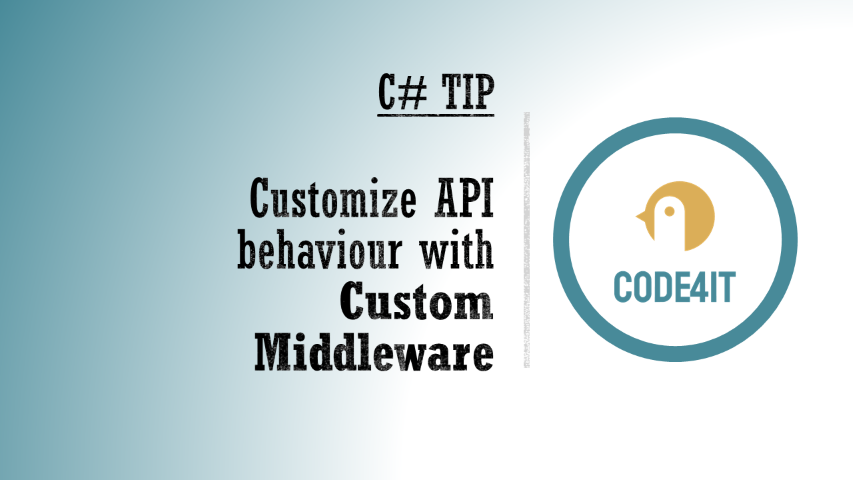C# Tip: 2 ways to define ASP.NET Core custom Middleware
Customizing the behavior of an HTTP request is easy: you can use a middleware defined as a delegate or as a class.
Table of Contents
Just a second! 🫷
If you are here, it means that you are a software developer. So, you know that storage, networking, and domain management have a cost .
If you want to support this blog, please ensure that you have disabled the adblocker for this site. I configured Google AdSense to show as few ADS as possible - I don't want to bother you with lots of ads, but I still need to add some to pay for the resources for my site.
Thank you for your understanding.
- Davide
Sometimes you need to create custom logic that must be applied to all HTTP requests received by your ASP.NET Core application. In these cases, you can create a custom middleware: pieces of code that are executed sequentially for all incoming requests.
The order of middlewares matters. Here’s a nice schema published on the Microsoft website:
A Middleware, in fact, can manipulate the incoming HttpRequest and the resulting HttpResponse objects.
In this article, we’re gonna learn 2 ways to create a middleware in .NET.
Middleware as inline delegates
The easiest way is to define a delegate function that must be defined after building the WebApplication.
By calling the Use method, you can update the HttpContext object passed as a first parameter.
app.Use(async (HttpContext context, Func<Task> task) =>
{
context.Response.Headers.TryAdd("custom-header", "a-value");
await task.Invoke();
});
Note that you have to call the Invoke method to call the next middleware.
There is a similar overload that accepts in input a RequestDelegate instance instead of Func<Task>, but it is considered to be less performant: you should, in fact, use the one with Func<Task>.
Middleware as standalone classes
The alternative to delegates is by defining a custom class.
You can call it whatever you want, but you have some constraints to follow when creating the class:
- it must have a public constructor with a single parameter whose type is
RequestDelegate(that will be used to invoke the next middleware); - it must expose a public method named
InvokeorInvokeAsyncthat accepts as a first parameter anHttpContextand returns aTask;
Here’s an example:
public class MyCustomMiddleware
{
private readonly RequestDelegate _next;
public MyCustomMiddleware(RequestDelegate next)
{
_next = next;
}
public async Task InvokeAsync(HttpContext context)
{
context.Response.Headers.TryAdd("custom-name", "custom-value");
await _next(context);
}
}
Then, to add it to your application, you have to call
app.UseMiddleware<MyCustomMiddleware>();
Delegates or custom classes?
Both are valid methods, but each of them performs well in specific cases.
For simple scenarios, go with inline delegates: they are easy to define, easy to read, and quite performant. But they are a bit difficult to test.
For complex scenarios, go with custom classes: this way you can define complex behaviors in a single class, organize your code better, use Dependency Injection to pass services and configurations to the middleware. Also, defining the middleware as a class makes it more testable. The downside is that, as of .NET 7, using a middleware resides on reflection: UseMiddleware invokes the middleware by looking for a public method named Invoke or InvokeAsync. So, theoretically, using classes is less performant than using delegates (I haven’t benchmarked it yet, though!).
Wrapping up
On Microsoft documentation you can find a well-explained introduction to Middlewares:
🔗 ASP.NET Core Middleware | Microsoft docs
And some suggestions on how to write a custom middleware as standalone classes:
🔗 Write custom ASP.NET Core middleware | Microsoft docs
I hope you enjoyed this article! Let’s keep in touch on Twitter or LinkedIn! 🤜🤛
Happy coding!
🐧


